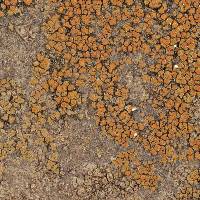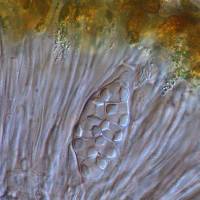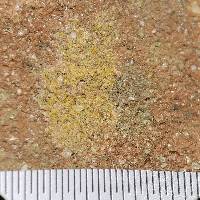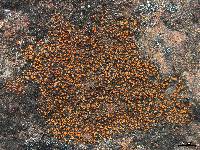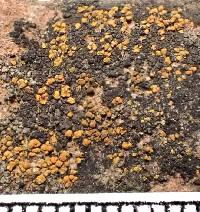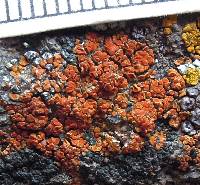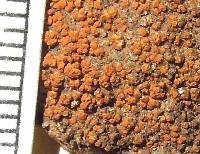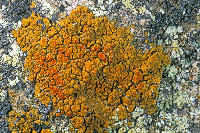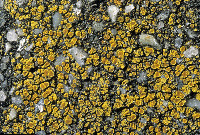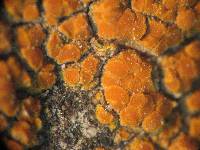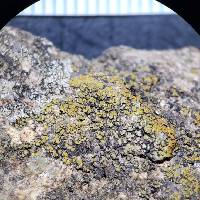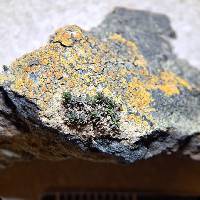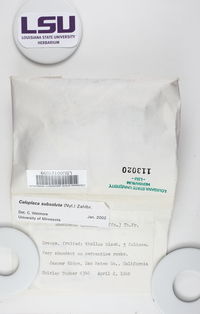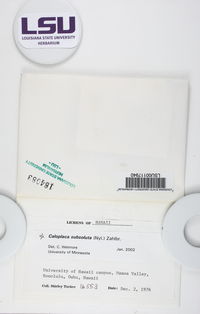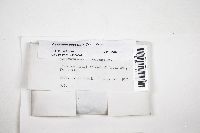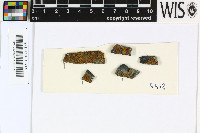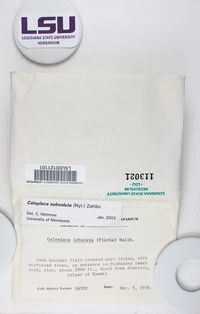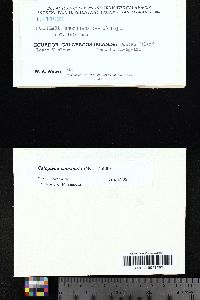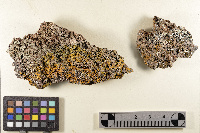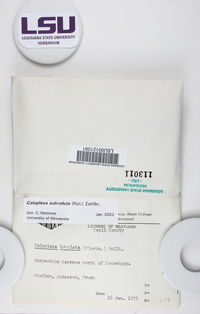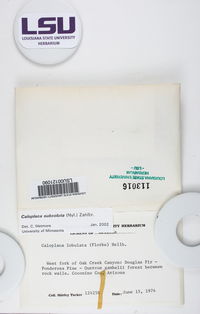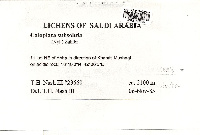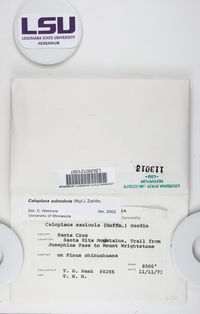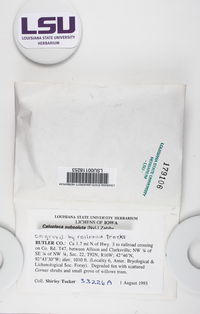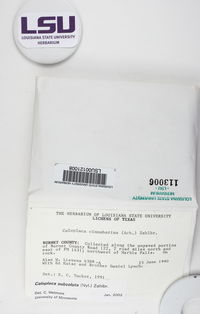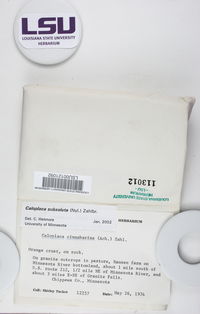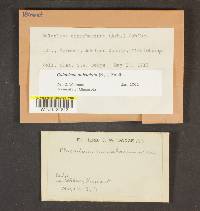
- Home
- Search
- Images
- Species Checklists
- US States: O-Z >
- US National Parks
- Central America
- South America
- US National Parks
- Southern Subpolar Region
|
|
|
|
Family: Teloschistaceae
[Blastenia novomexicana Fink ex J. Hedrick, moreCallopisma americanum Malme, Callopisma aurantiacum var. irrubescens Arnold, Callopisma irrubescens (Arnold) Arnold, Caloplaca americana (Malme) Zahlbr., Caloplaca aurantia var. irrubescens (Arnold) Jatta, Caloplaca irrubescens (Arnold) Zahlbr., Caloplaca modesta (Zahlbr.) Fink, Caloplaca novomexicana (Fink) ined., Caloplaca subsoluta (Nyl.) Zahlbr., Caloplaca subsoluta f. subsoluta (Nyl.) Zahlbr., Lecanora murorum var. subsoluta Nyl., Lecanora subsoluta (Nyl.) Nyl., Physcia subsoluta (Nyl.) Arnold, Placodium americanum (Malme) Räsänen, Placodium aurantiacum subsp. irrubescens (Arnold) A.L. Sm., Placodium subsolutum (Nyl.) H. Olivier, Teloschistes modestus (Zahlbr.) Fink, Xanthoria modesta Zahlbr.] |
MB#802121 Basionym: Lecanora murorum var. subsoluta Nyl., Flora, Regensburg 56: 197. 1873; MB#604472. Taxonomic note. The name is here applied in the widest sense. Material includes both specimens that more closely resemble the barely squamulose morphotypes of S. subsoluta s.str., as well as others that are distinctly squamulose and thus more closely resemble S. aff. squamosa. Although some Galapagos material phylogenetically seems to be part of S. subsoluta s.str., most specimens are part of various different other clades. They cannot presently adequately be assigned to any named taxon within Squamulea. Description. Thallus very variable, areolate to indistinctly subsquamulose, up to 3 cm in diam., but several thalli often merging, often confluent, individual areoles flattened to barely convex, edges mostly turned downward, areoles loosely dispersed to aggregating into small groups with few immersed to adnate apothecia, effuse, not delimited by a prothallus, hypothallus absent; surface smooth, ± waxy, but not shiny, pale yellow orange to deep orange, epruinose; very rarely sorediate; soralia erumpent, 0.1–0.3(–4) mm in diam., occasionally confluent, irregularly extruding deep orange or deep yellow, granular soredia (35–50 μm in diam.). Apothecia numerous, dispersed to ± aggregated, sometimes crowded, sessile, up to 0.6 mm in diam., lecanorine; thalline margin persistent, not excluded, slightly prominent, regularly circular, not flexuose, almost level with disc, (40‒)60‒80 μm thick, concolorous with thallus, epruinose, rarely whitish pruinose in parts, C-, K+ purple; disc flat to slightly convex, deep orange, darker than the margin, mostly epruinose, rarely faintly whitish pruinose in parts, C-, K+ purple; epihymenium with orange pigment granules, C+ red, K+ purple, pigmentation contiguous with the outer exciple, hymenium hyaline, not inspersed; proper exciple absent (completely reduced); thalline exciple differentiated into an inner, hyaline part, a central part with large trebouxioid photobionts, lacking crystals (or rarely with very few, small crystals, dissolving in K), and an outer, deeply brownish orange part, with abundant pigment granules, C+ red, K+ purple; subhymenium and hypothecium not differentiated, hyaline, not inspersed, paraplectenchymatous, with large, rounded to ± angular cells; asci broadly to narrowly clavate, Teloschistes-type; ascospores 8/ascus, polaribilocular, oblong to narrowly or broadly ellipsoid to almost globose often with slight median swelling at the septum, (7.5–)8.4–13.3(–17.3) × (4.0–)5.2–7.0(–7.8) μm, with a moderately thickened, (1.7–)2.5–3.9(–5.0) μm wide septum (n = 90). Pycnidia not observed. Chemistry. Thallus and apothecia P–, K+ purple, C–, KC± purplish, UV– (dull); thallus and apothecia contain high proportions of parietin and lesser proportions of teloschistin, fallacinal, parietinic acid and emodin corresponding to chemosyndrome A sensu Søchting (1997); some specimens analyzed correspond to chemosyndrome A3 sensu Søchting (1997). Ecology and distribution. Squamulea subsoluta, as currently delimited, has a world-wide, cosmopolitan distribution, unlike its similar counterpart Squamulea squamosa (B. de Lesd.) Arup, Søchting & Frödén, which Wetmore (2003, 2007a) suggests is restricted to southwestern North America. In Galapagos, S. subsoluta s.l. is common throughout all vegetation zones, often growing in nutrient-rich situations and then frequently blackened by cyanobacteria growing in between its thallus areoles. Notes. Our current phylogenetic analysis was unable to clearly resolve the different groups of Squamulea squamosa/subsoluta. Although we included in our analyses numerous specimens also from outside Galapagos, the resolution of this group remains taxonomically challenging. Most specimens cited below belong to the typical morphotype of S. subsoluta: their thalli are thin, poorly developed, composed of ± angular to barely subsquamulose epruinose areoles, without a distinct pro- or hypothallus. Some of these specimens appear phylogenetically more closely related to S. loekoesiana than to S. subsoluta s.str. Morphologically, all specimens are not clearly distinguished from the phylogenetically distinct S. chelonia, S. humboldtiana, and S. oceanica. Few specimens in Galapagos have a more distinct squamulose morphology. In our phylogenetic tree, these specimens (labeled ‘squamosa 2 & 3’) appear closely related to S. squamosa s.str. The specimens, however, do not belong to the same clade and as soon as more Nash, T.H., Ryan, B.D., Gries, C., Bungartz, F., (eds.) 2007. Lichen Flora of the Greater Sonoran Desert Region. Vol 3. Life habit: lichenized Thallus: squamulose, areolate or subsquamulose, margin slightly lobed or notched, without elongated lobes; prothallus: present, black surface: orange, smooth, without asexual propagules cortex: cellular, 15-30 µm thick, granules absent; medulla paraplectenchymatous, without granules Apothecia: adnate, 0.1-0.6 mm in diam., lecanorine disc: orange, flat, epruinose margin: persistent, flush; thalline margin present or absent, concolorous with thallus; proper margin visible, concolorous with disc parathecium: cellular (paraplectenchymatous) including exciple below hypothecium epihymenium: golden, K+ red, 10%N-, cN-, C- hymenium: hyaline, 60-80 µm tall paraphyses: 2-3 tip cells slightly swollen, with few branches; subhymenium hyaline asci: cylindrical, 8-spored ascospores: hyaline, 2 locules, ellipsoid, 9.5-12.5 x 5.5-7 µm, isthmus 3-4 µm, spore end wall thin Pycnidia: present, mostly immersed, ostiole orange Spot tests: apothecial margin K+ red, 10% N-, cN-; thallus K+ red, 10%N-, cN-, C-, medulla IKI- Secondary metabolites: parietin, fallacinal, emodin, and teloschistin. Substrate and ecology: on non-calcareous or calcareous rocks World distribution: worldwide Sonoran distribution: southern California, Arizona, Baja California, Baja California Sur, western Chihuahua, Sonora, and northern Sinaloa. Notes: See notes under C. squamosa. |
|
|
|



